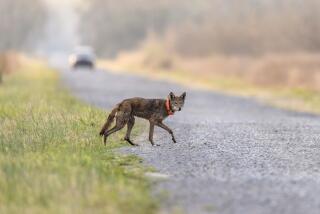America the Wild: On Safari for Exotic and Rare Species
- Share via
You don’t have to go on an African safari to see spectacular concentrations of wildlife or rare or exotic species. Scattered across the United States are 508 National Wildlife Refuges, where travelers can readily view vast flocks of migratory birds or watch herds of elk, moose, antelope and bison in their natural habitat. It’s a lot cheaper than getting to Africa, and you might find it just as interesting.
A few years back I was thrilled to observe a huge herd of elk in the wild at the National Elk Refuge just outside Jackson, Wyo. In winter, as many as 12,000 of the animals descend from the snow-clogged slopes of the Rocky Mountains to the more congenial climate of the Jackson Hole valley. I climbed aboard a horse-drawn sleigh and glided among them.
Only a dozen yards from my sleigh, a pair of young bulls with heads lowered sparred with their heavy sets of antlers. The antlers clicked noisily, a distinctive sound that drew my attention to dozens of other sparring bulls in every direction I looked. It was an awesome sight, and I thought this must be what it was like for the frontiersmen of centuries past who saw the great herds of animals that once roamed the North American continent.
Viewing is seasonal at many refuges, so call ahead to find out just when wildlife will be present.
At DeSoto National Wildlife Refuge near Council Bluffs, Iowa, as many as half a million snow geese pause in November--sometimes for many weeks--in their long flight from the Arctic Circle to their winter quarters in the Texas marshes on the Gulf of Mexico. The geese are attracted by the refuge’s mile-long oxbow lake, which once was a part of the Missouri River.
The geese linger until the lake begins to freeze, which can occur as early as November or as late as January.
Among the National Wildlife Refuge system’s many other upcoming wildlife spectaculars:
At Bosque del Apache, Socorro, N.M., as many as 25,000 greater sandhill cranes winter from November through February, a big lure for nature photographers who like to snap them as they take flight en masse at dawn and at sunset. This is one of the largest concentrations of sandhill cranes anywhere.
At National Bison Range, Moiese, Mont., visitors taking the 19-mile scenic drive (up a sometimes steep gravel road) can expect to see at least part of the refuge’s herd of up to 500 bison. But the grasslands also support antelope, elk, mule deer, white-tailed deer and big horn sheep--and occasionally a shy mountain goat can be spotted. Winter is the quiet season, and spring brings the newly born.
Kilauea Point, on the Hawaiian island of Kauai, rewards nature lovers year-round with a rare opportunity to walk among large colonies of seabirds in an area of great natural beauty. With care, you can recognize frigate birds, red-footed boobies, albatrosses and nene geese, the stately state bird of Hawaii that once was nearly extinct.
At Crystal River, Crystal, Fla., about 300 migrating manatees have begun arriving for the winter. Lovably ugly, the huge, gentle creatures seek sanctuary annually in the warm spring waters of King’s Bay at the mouth of the Crystal River. To see manatees up close, sign up for a snorkeling cruise offered by one of the refuge-sanctioned dive shops in Crystal.
The J. N. “Ding” Darling Refuge on Sanibel Island, Fla., is home to a wide variety of wading birds--herons, egrets, ibises, wood storks and roseate spoonbills--that can be seen in a five-mile drive among marshes and mangroves. The road is sand and shell, and the greatest concentration of birds is from January into April.
Aransas National Wildlife Refuge, Austwell, Texas, is where the endangered whooping cranes spend the winter, arriving from Canada in small family groups of two and three from their breeding grounds in the Northwest Territories of Canada. Last season, a peak of 158 of the regal 5-foot-tall birds was counted at Aransas. They can be viewed in small numbers from the refuge’s observation tower or along its 16-mile-long auto loop.
Okefenokee, Folkston, Ga., the famous swamp, abounds with alligators year-round--as many as 10,000 to 12,000, which visitors can see in large numbers either on an escorted boat tour or by renting a canoe or motorboat and following the refuge’s well-marked water trails.
Many refuges feature visitor centers of the sort found in U.S. national parks, and other facilities have been provided to aid in viewing or photographing. Boardwalks, hiking trails and canoeing routes have been developed at some refuges, and others offer self-guided auto routes.
The U.S. Fish and Wildlife Service offers several tips for visiting a wildlife refuge:
* Call ahead to determine the prime time for viewing, opening days and hours, entrance fees and special activities.
* Bring binoculars.
* Arrive early in the morning or late in the afternoon. These are the times when wildlife is most active.
* Keep your distance. Wildlife can be dangerous to you or in fleeing you they can endanger themselves. Don’t make noises to attract an animal’s attention and don’t feed them.
* Remain in your vehicle on a tour-route or road. You are less likely to frighten away the wildlife.
* Leave only footprints. Stay on the trails to avoid trampling vegetation and don’t pick the flowers because they may be food for the butterflies.
For a visitor’s guide and map listing all the national wildlife refuges, call (800) 344-WILD ([800] 344-9453). For a detailed look at each of the wildlife refuges, consult “Guide to the National Wildlife Refuges” by Laura and William Riley (Collier, $16).
Times’ Travel writer Christopher Reynolds is on vacation.
More to Read
Sign up for The Wild
We’ll help you find the best places to hike, bike and run, as well as the perfect silent spots for meditation and yoga.
You may occasionally receive promotional content from the Los Angeles Times.






